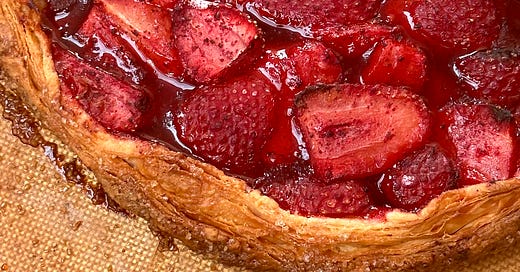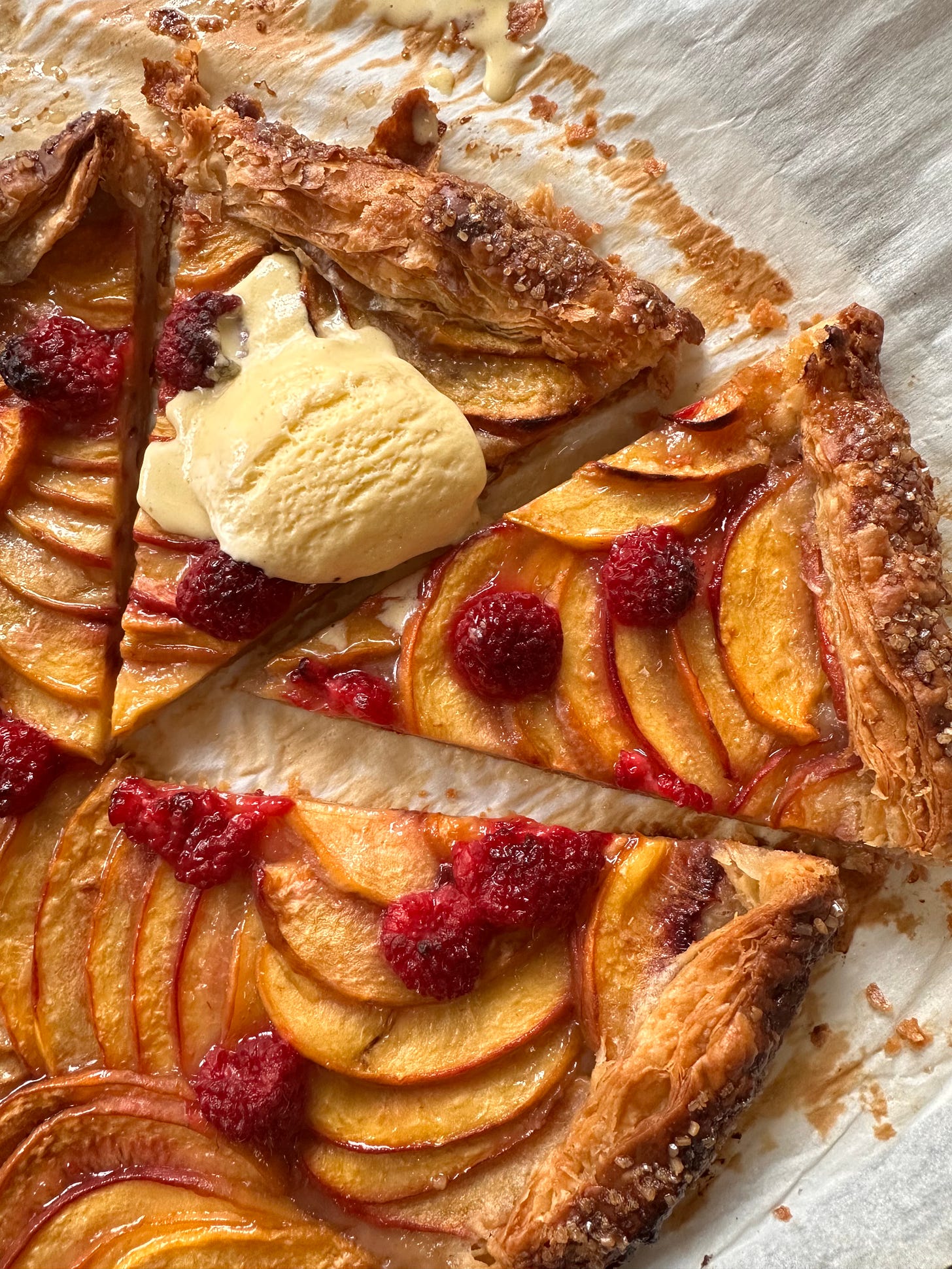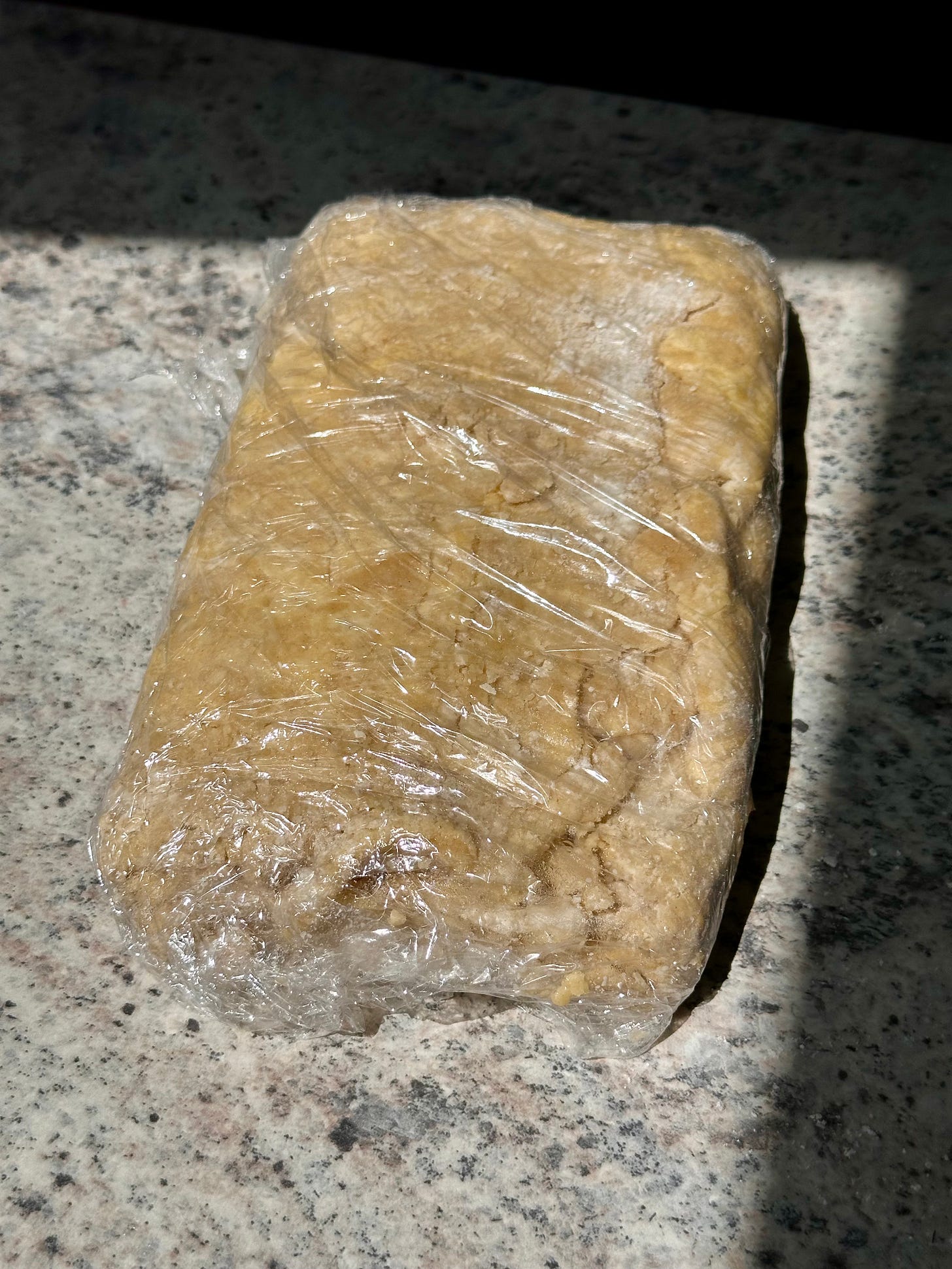Small Win #25: If you only learn to make one dessert
How to galette + the usefulness of ratios in baking
Welcome to Small Wins, a newsletter that shares a small win with you every other week — one that has the power to improve your cooking, your home, your life. If you’ve found your way to this newsletter but are not yet subscribed, here, let me help you with that:
A homemade pie is super nostalgic to some, but the French have always leaned more towards rustic galettes — a freeform kind of tart — and I’m with them on this one.
… Is there anything more pretty? More effortlessly chic?
I love that galettes have a higher ratio of fruit to pastry. I love that the beauty of the fruit is visible. I love that they can be served at any temperature (warm, room temp, cold).
But what I love most is how doable they are.
Far easier and less stressful than a pie, fruit galettes are available to every cook, no matter what level. Grab a sheet of ready-made puff pastry, toss some berries with some sugar, lemon juice and cornflour and it’s possible to have a galette in the oven within all of 20 minutes.
But of course I’m going to encourage you to make the pastry — not because making your own pastry carries any inherent virtue, but because this is hands down my favourite kind. It’s pie dough, folks — or as the French call it, pâte brisée.
Here’s why it’s pretty much the only type of pastry that I make these days: it’s buttery, it’s flaky and it works for both savoury and sweet but it doesn’t require the technical know-how of puff. Even better: it all comes down to a simple ratio that, once memorised, will enable you to make it repeatedly without ever having to open a cookbook (or consult Google). I’m pretty certain you’re going to fall for it as hard as I have.
Love,
Alexina
Coming up — The Small Wins index!! And also a little summer break, more on which in next week’s newsletter.
RATIOS: THE BACKBONE OF BAKING

Pastry chefs probably won’t appreciate me sharing this, but most baking is based on a few core ratios. A classic shortcrust pastry is two parts flour to one part fat (plus a little water to bind). A Victoria Sponge is equal parts butter, sugar, eggs and self-raising flour. Meringues are two parts sugar to one part egg whites. A basic chocolate ganache is two parts liquid (typically cream) to one part chocolate. It’s a lot more formulaic than you might think.
This isn’t to undersell the job of a pastry chef or baker – the technique, or how the ingredients are put together, is crucial. Nevertheless, by memorising a handful of ratios, you’ll be able to turn out various breads and cakes at a moment’s notice without being enslaved to a recipe.
And whilst ratios might sound like a fixed concept, in reality they are the foundations on which intuitive baking is built: you start with the ratio, and then you respond to your ingredients live. Dough feel a bit dry? Add a touch more liquid. Cake batter feel a bit stiff? Pour in a little milk… Ratios, not rules!
So today we’re going to look at a ratio for a basic pie dough — which, to my mind, is the best (and arguably only) pastry you need ever learn. Sure, shortcrust and pâte sucrée have their place but primarily in more cheffy/formal dishes. For the type of cooking that I do at home my main criteria is ‘delicious’ and pâte brisée is that.
This is the ratio that I use:
4 parts flour : 3 parts fat : 1 part water : 1 part sour cream
The other additions (based on 400g flour) are:
sugar for caramelisation - 3 tbsp if making a sweet tart, 1 tbsp for savoury
flaky salt for flavour - 2 tsp
The brilliant thing about having a ratio is that it enables you to play. A basic pie dough can be made with plain flour and butter, but you could also experiment with:
Swapping up to 25% of the flour for something like rye, wholemeal or even polenta
Swapping some of the butter for lard (for a more savoury pastry), or grated cheese
Playing with other dairy products such as buttermilk, creme fraiche
Adding in flavourings such as citrus zest or spices like cinnamon
Now that we’ve got the formula down, it’s time for the all-important method…
4-3-1-1 PIE DOUGH
A couple of things to say upfront here:
This is going to appear more involved than a classic shortcrust pastry — and it is, because hello folds! — but I promise you it’s very doable and also a lot more fun.
Everything should be COLD. If you have the time / foresight, weigh the flour into the bowl you’re going to use and pop it in the fridge or freezer for a bit.
It’s true: the current heatwave will make your life a little harder — if you’re nervous, save this for when the temperatures come down.
A dough scraper is extremely handy here — you want one of the bigger, sturdy ones like this.
I’ve filmed the whole process just so that you can see how chaotic it looks (particularly so because of the 30 degree heat), and how, yes, it will all work out.
The way that you squish the butter into flat pieces is one that I learnt from Nicola Lamb and whilst a lot of recipes for pie dough will have you grate the butter, or rub it into the flour, this way of doing it gives you amazing layers!
This pastry requires an overnight rest in the fridge (4 hours at the minimum).
Makes enough pastry for 2 galettes/tarts — I always freeze half!
Ingredients
400g plain flour
4 tbsp caster sugar
2 tsp flaky salt
300g salted butter, fridge-cold and cut into 1.5cm / 3/4” cubes
100ml ice-cold water
100ml sour cream, fridge-cold
Method:
Combine the water and sour cream, then place in the fridge to stay cold.
In a medium to large bowl, whisk together the flour, sugar and salt, then toss through the cubes of butter until they’re all coated (this will insulate the butter from the warmth of your hands).
One by one, squish the butter into flat pieces, like this (return the bowl to the fridge after this step if conditions are warm):
If conditions are hot, from this step onwards you want to work speedily and dust your rolling pin / dough scraper with flour as required. Stir the water-sour cream mix into the flour-butter and as soon as it’s vaguely coming together (it will still be all over the place), tip the dough onto your work surface and squash everything together as best you can. Attempt to roll out the dough into a long rectangle that’s 2 to 3 times longer than it is wide, using a dough scraper or the side of a rolling pin) to nudge the pastry into the desired shape:
Place any dry bits that won’t stick into the middle of the rectangle then ease the dough scraper under the top third of the pastry and flip it over into the middle. Do the same thing to fold the bottom third into the middle. Congratulations, you’ve performed what bakers call a single turn!
Now turn the pastry 90 degrees and repeat this whole process two more times. The dough will become progressively more homogenous as you do this, and you’ll see streaks of butter start to develop, like marble. Highly satisfying.
Wrap the pastry in cling film (it will not look perfectly even and smooth and that’s okay!) and place in the fridge overnight (or min. 4 hours). After this time, the pastry can be cut into two pieces and one (or both) transferred to the freezer, if you like. Roll out as required — you’ll be amazed at how time has transformed it.
STRAWBERRY + SUMAC GALETTE
If using shop-bought pastry sheets, you may need less filling.
Ingredients
For the filling:
400g strawberries, halved or quartered
Juice of 1/2 lemon
3 tbsp caster sugar
1 tbsp sumac, or to taste — I was recently gifted some beautiful sumac from Arabica, who do a gorgeous selection of hampers full of Middle Eastern ingredients
1 1/2 tbsp cornflour (or potato starch, which gives a glossier effect in my experience!)
Pinch of fine sea salt
To compile:
1/2 x qty of pie dough (or shop-bought flaky pastry)
1 x qty of filling (above)
Whole milk/double cream/egg wash, to glaze the border
Demerara sugar
Single or double cream, to serve
Method
Preheat the oven to 170°C fan/190°C/375°F/gas 5.
Combine the fruit in a bowl and squeeze over the lemon juice. Separately, whisk together the sugar, cornflour and salt, then add this to the fruit and gently toss everything together.
Roll out the pastry to 4mm (1/4in) thick, then cut out a circle, around 30cm (12in) in diameter. Spread out the strawberries over the middle of the pastry disc, leaving a 3cm (1in) border around the edge. Fold the pastry over the fruit to create a border all the way around. Brush the pastry edges with milk, then sprinkle with the demerara sugar.
Bake until deeply golden, around 50 minutes, then allow to cool for around 10 minutes before serving with a drizzle of cream.
When it comes to baking with pie dough (or puff pastry) it always needs longer in the oven than you think. You’ll be tempted to remove this galette halfway through the cooking time, but you’ll be rewarded if you hold out. Keep an eye on it in the last 15 minutes of baking, and turn the oven down if it’s getting too dark or the filling seems to be drying out.
PLUS SOME OTHER GALETTE VARIATIONS THAT I ADORE!

To make these you can essentially use the same proportions of fruit, cornflour etc. as used for the strawberry galette above. Frozen berries work well.
Blackcurrant, blueberry + liquorice (from my cookbook Bitter) — 300g blueberries, 100g blackcurrants, 1.5 tsp fine liquorice powder (or to taste).
Peach melba (from my cookbook Sweet) — 300g peaches, 100g raspberries. Serve with vanilla ice cream.
Apple & blackberry — 300g Granny Smith apples, 100g blackberries. This is real good served with a bay-infused cream (250ml cream briefly heated with 4 fresh bay leaves + 1 tsp light brown sugar then left to cool — a genius recipe by the wonderful
, author of I’ll Bring Dessert).Plum + star anise — A combination I could never, ever tire of and that I used on MasterChef when cooking for Jay Raynor. 400g plums + couple of pinches of ground star anise.








Thanks Alexina - I will definitely be trying some of your galette recipes with the abundance of local, in season fruit over the coming summer and early autumn.
This looks lush and perfect for where I live, Fife, where, hands-down, the UK’s best strawberries are grown! Quick question about the sumac—can’t see which stage it gets added?